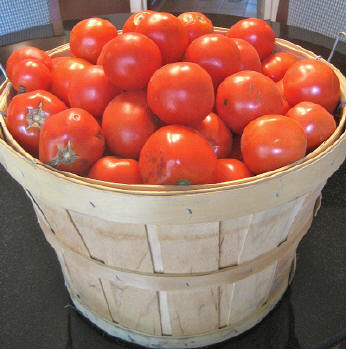 Many vegetable gardeners know well the thrill of growing tomatoes, but how many tomatoes do you really need? During the 1940s and continuing well into the 1960s and 1970s, home gardening became popular.
Many vegetable gardeners know well the thrill of growing tomatoes, but how many tomatoes do you really need? During the 1940s and continuing well into the 1960s and 1970s, home gardening became popular.
The Victory Gardens of the 1940s sowed the seeds of excitement in vegetable growing, especially tomatoes. Working men like my dad, uncles and many neighbors became obsessed with growing the earliest tomato, the largest beefsteak tomato and the best producing canning tomato. The garden plot was enriched with horse or cow manure, compost, lime, leaf mold and other
amendments, then double shoveled or rototilled to make it ready to plant in spring.
Every summer the earliest tomato, the largest beefsteak and the most productive canner tomatoes were collected and dissected to get the seeds for next years tomatoes. Dried and stored in white envelopes in the cellar or someplace cool.
 In my dads’ garden plot I became a lover of those wonderful tomatoes. Many, seasons later, as a retired teacher and a Master Gardener living in PA, with a large vegetable garden, the tomato disease overtook me once again. If searching for any new heirloom, hybrid or unusual tomato sounds familiar to you this article may help you. Every season I make a resolution to
limit the amount of tomato plants in my garden, then I open catalogs, and visit plant nurseries and become seduced by the many new and exciting choices.
In my dads’ garden plot I became a lover of those wonderful tomatoes. Many, seasons later, as a retired teacher and a Master Gardener living in PA, with a large vegetable garden, the tomato disease overtook me once again. If searching for any new heirloom, hybrid or unusual tomato sounds familiar to you this article may help you. Every season I make a resolution to
limit the amount of tomato plants in my garden, then I open catalogs, and visit plant nurseries and become seduced by the many new and exciting choices.
This spring I took a class from a tomato specialist with the hopes of narrowing my plant choices, however I just included some better types along with the rest. The growing tips were great, now I can look forward to a much larger harvest. Thanks’ Steve. Harvest time rolls around I often have a few too many tomatoes, even after giving tomatoes to extended family,
neighbors, postal drivers and visitors.
Bring in your baskets of tomatoes and herbs and admire them, their lovely colors, contours and sizes. I often view the baskets of tomatoes on my kitchen counter as Peale still life paintings.
To use the many tomatoes, I can tomatoes, tomato sauce, salsa, pizza sauce and barbeque sauce. I have developed a few quick, easy and delicious recipes to use those few extra tomatoes.
Tomato Appetizer
- 1 loaf of French, Italian, or long bread of your choice
- 6 to 8 tomatoes, depending on size. I mix up reds, yellows, oranges or whatever I have
- Olive oil or other oil
- Fresh garlic, chopped very fine, or garlic salt or powder
- Herbs such as basil, oregano, fennel, thyme, marjoram or mint, and salt and pepper
- Heat oven to 375 degrees with rack in middle of the oven
Split bread in half lengthwise, using both halves, brush with olive oil, sprinkle with salt, pepper and garlic. Place on large oven sheet and bake until lightly golden and crispy.
Slice tomatoes ¼" thick (depending on the size and shape of tomatoes you can decide how to slice) place on bread in one layer straight across, diagonally or anyway. I use different colors, sometimes it looks like part of a rainbow. Add herbs fresh or dried, a very thin dribble of oil and slice into 2" to 3" slices. Serve as appetizer, luncheon or side dish. Delicious
Oven baked tomato sauce
- Heat oven to 375 degrees
- Line a large oven sheet with aluminum foil and spread 3 tablespoons of olive oil or vegetable oil on sheet.
- Plum tomatoes, or small tomatoes with not a lot of seeds, cut in 2" pieces
- Onions thinly sliced -- I use a large candy or Vidalia, or you can use any type you like
- 2 medium garlic gloves put through garlic press or chopped fine
- Fresh or dried basil, oregano, parsley, but dried works well too.
Spread tomatoes, onions, garlic, herbs, salt and pepper on tray; toss well to cover with olive oil on bottom of pan (you can use more oil if you like). Place in oven and cook for 40 to 60 minutes until they are slightly caramelized.
Serve on pasta; I like thin spaghetti, capellini, or small penne. Also delicious over toasted English muffins, baked potatoes or couscous. You can make extra sauce and freeze for up to 3 months.
Fruit salad
- Fresh sliced tomatoes
- Fresh sliced watermelon, cantaloupe, or honeydew melon
- Fresh blueberries
- Olive oil and balsamic vinegar
- Salt, fresh chopped mint or basil
- Pine nuts (optional)
Mix fruit (you can use all or just one kind of melon) and nuts in bowl or layer on plate, combine olive oil, balsamic vinegar, herbs and spices. Pour over fruit or toss in bowl. Wonderful
I hope these recipes will be helpful. I love tomatoes.
Read other articles on growing herbs or vegetables
Read other articles by Marlene Spinosa